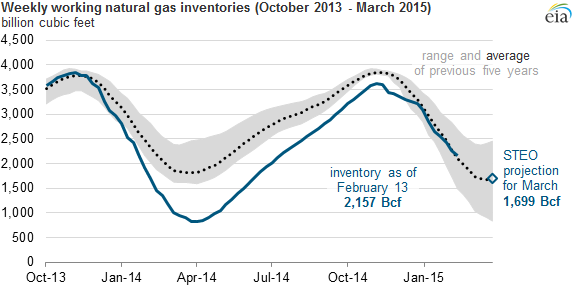Working natural gas storage has surpassed five-year average levels for the first time in more than a year, reports the Energy Information Administration (EIA). At 2,157 Bcf as of February 13, stocks are 58 Bcf greater than the five-year average.
The last time inventories surpassed the five-year average was in November of 2013. Inventories ended the 2013-2014 winter withdrawal season last March at a 10-year record low of 837 Bcf.
Despite several near-record withdrawals early this heating season, overall withdrawals this season have been significantly lower than the record levels seen last year, and 16% lower than the five-year average. The EIA currently anticipates that inventories will end this injection season at 1,699 Bcf, 43 Bcf more than the five-year average, due to recent production growth and moderate demand.
The EIA forecasts that total natural gas consumption in the United States will average 88.1 Bcf/day for the remainder of the heating season, down 3% from 90.9 Bcf/day during the same period in 2014. Above-average temperatures experienced in the western half of the U.S. is expected to offset the consumption in other parts of the country, dampening overall natural gas consumption.
Important disclosures: The information provided herein is believed to be reliable; however, EnerCom, Inc. makes no representation or warranty as to its completeness or accuracy. EnerCom’s conclusions are based upon information gathered from sources deemed to be reliable. This note is not intended as an offer or solicitation for the purchase or sale of any security or financial instrument of any company mentioned in this note. This note was prepared for general circulation and does not provide investment recommendations specific to individual investors. All readers of the note must make their own investment decisions based upon their specific investment objectives and financial situation utilizing their own financial advisors as they deem necessary. Investors should consider a company’s entire financial and operational structure in making any investment decisions. Past performance of any company discussed in this note should not be taken as an indication or guarantee of future results. EnerCom is a multi-disciplined management consulting services firm that regularly intends to seek business, or currently may be undertaking business, with companies covered on Oil & Gas 360®, and thereby seeks to receive compensation from these companies for its services. In addition, EnerCom, or its principals or employees, may have an economic interest in any of these companies. As a result, readers of EnerCom’s Oil & Gas 360® should be aware that the firm may have a conflict of interest that could affect the objectivity of this note. The company or companies covered in this note did not review the note prior to publication. EnerCom, or its principals or employees, may have an economic interest in any of the companies covered in this report or on Oil & Gas 360®. As a result, readers of EnerCom’s reports or Oil & Gas 360® should be aware that the firm may have a conflict of interest that could affect the objectivity of this report.
Analyst Commentary
Raymond James Equity Research 02.20.2015
This week's withdrawal comes in line with consensus forecast; y/y storage surplus continues to grow.
This week's reported withdrawal of 111 Bcf was in line with consensus and above the Raymond James estimate. This withdrawal implies that we were 1.0 Bcf/d looser than last year, and we have averaged 1.7 Bcf/d looser over the past four weeks. Moving into next week, we expect a ramp up in withdrawals with colder weather. At the end of last winter, the fear was not being able to add enough storage in preparation for this winter. However, this is clearly no longer the case in 2015. With the amount of supply flooding the market, we believe there will be ample storage as we move into the injection season, setting us up for a significant storage glut. Thus, we reiterate our bearish stance on natural gas prices.


